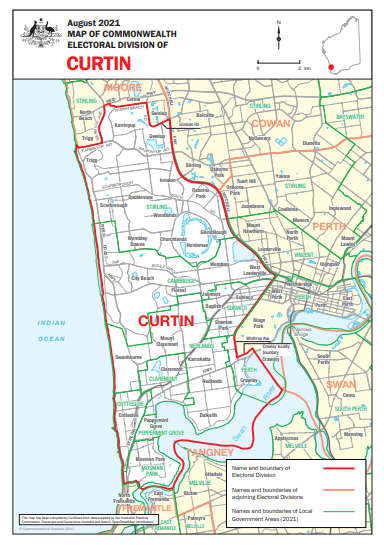|
|
|
|
| Adam Carr's Election Archive
|
Australian federal election, 2022
Division of Curtin, Western Australia
Named for: Rt Hon John Curtin (1885-1945), federal MP 1928-31, 1934-
45, Leader of the Opposition 1935-41, Prime Minister 1941-45
Western Perth: Churchlands, Innaloo, Nedlands, Scarborough, Subiaco
State seats: All of
Churchlands and
Nedlands, parts of
Carine,
Cottesloe and
Scarborough
Local government areas: All of
Cambridge,
Cottesloe,
Mosman Park,
Nedlands,
Peppermint Grove and
Subiaco, parts of
Perth and
Stirling
Borders with:
Cowan,
Fremantle,
Moore and
Perth
Enrolment at 2019 election: 100,365
Enrolment at 2022 election: 119,397 (+19.0)
1999 republic referendum: Yes 55.5
2018 same-sex marriage survey: Yes 72.2
Sitting member: Celia Hammond (Liberal):
Elected 2019
2007 Liberal majority over Labor: 13.6%
2010 Liberal majority over Labor: 16.2%
2013 Liberal majority over Labor: 17.4%
2016 Liberal majority over Labor: 20.7%
2019 Liberal majority over Labor: 14.3%
2022 notional Liberal majority over Labor: 13.9%
Liberal two-party vote 1983-2019
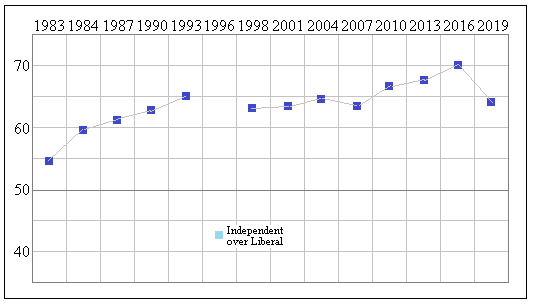
Status: Safe Liberal
Best Liberal booths, two-party vote: Dalkeith (78.9), City Beach (76.2),
City Beach North (76.2), Cottesloe (71.5), Floreat East (70.1)
Best Labor booths, two-party vote: Nedlands Central (56.8), Innaloo (48.6),
Shenton Park West (47.5), Scarborough Central (46.7), Karrinyup South (44.9)
2019 results
Statistics and history
Candidates in ballot-paper order:
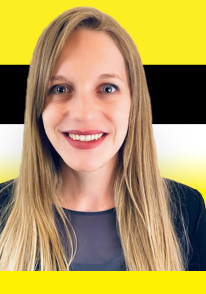 |
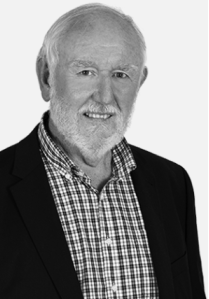 |
 |
 |
1. Ladeisha Verhoeff
United Australia Party |
2. Dr Bill Burn
Western Australia Party |
3. Judith Cullity
Australian Federation Party |
4. Celia Hammond
Liberal Party |
 |
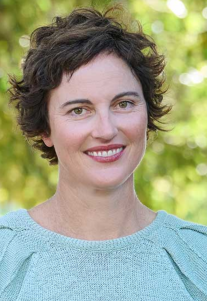 |
 |
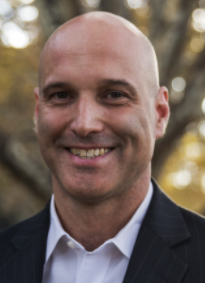 |
5. Dale Grillo
Pauline Hanson's One Nation |
6. Kate Chaney
Voices of Curtin |
7. Yannick Spencer
Australian Labor Party |
8. Cameron Pigeon
Australian Greens |
Candidate websites:
Dr Bill Burn
Kate Chaney
Judith Cullity
Celia Hammond
Cameron Pigeon
Yannick Spencer
Ladeisha Verhoeff
Division of Curtin
Curtin was created in 1949, based in Perth's western beachside suburbs. This is the most affluent part of Perth and the
seat has never come close to electing a Labor member. Subsequent redistributions have extended the seat northwards into
slightly less affluent areas, without much weakening the Liberal position. Curtin has among the country's highest median
family incomes and highest levels of people in professional and managerial occupations. It is also an ageing area with a fairly high
level of over 65s and a fairly low level of families with dependent children. It has a high level of immigrants
from the UK, but is otherwise fairly monocultural.
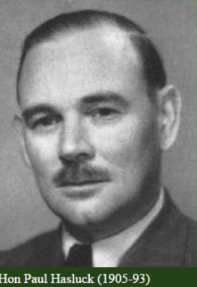 The first member for Curtin was
Sir Paul Hasluck, Liberal foreign minister and later Governor-General.
Allan Rocher, elected in 1981, resigned from the Liberal Party after being replaced as Liberal candidate for the 1996 election by
Ken Court, the Premier's brother. He retained the seat as an independent, but was defeated in 1998 by
Julie Bishop.
The first member for Curtin was
Sir Paul Hasluck, Liberal foreign minister and later Governor-General.
Allan Rocher, elected in 1981, resigned from the Liberal Party after being replaced as Liberal candidate for the 1996 election by
Ken Court, the Premier's brother. He retained the seat as an independent, but was defeated in 1998 by
Julie Bishop.
Bishop was a favourite of Prime Minister
John Howard and was a senior minister in his government's last term. She was elected
Deputy Leader of the Liberal Party after the 2007 election defeat, and retained the position under four successive Liberal leaders. She was
Minister for Foreign Affairs from 2013 to 2018. In August 2018 she made a bid for the Liberal leadership but was
out-manoeuvred by
Scott Morrison, and finished third in the party-room ballot. In February 2022 she announced that she would not
contest Curtin again.
Celia Hammond, Liberal MP for Curtin since 2019, is a lawyer and was a law lecturer at the University of Western Australia and at Notre Dame, a
Catholic university, where she was Vice-Chancellor from 2008 to 2019. She is notably more conservative than Bishop, being a climate
denialist and a critic of "militant feminists." This did not her prevent easily winning Curtin in 2019. The
2021 redistribution has extended the seat northwards into slightly more marginal territory. The Labor candidate is Yannick Spencer, who works
for a management consulting firm. The Greens candidate is Cameron Pigeon, a teacher. A much more serious
challenge will come from Kate Chaney, running for the "Voices of" movement. Chaney is the niece of one former Liberal minister Fred Chaney and the grand-daughter
of another, the late Sir Federick Chaney.
The state seats in this area produced huge swings to Labor at the 2021 state election. This was
entirely due to state issues and should not be taken as an indicator that similar results
can be expected in WA at a federal election.
Demographics:
Median weekly household income: $2,052 (Australia $1,438)
People over 65: 16.5% (Australia 15.8%)
Australian born: 60.3% (Australia 66.7%)
Non-English-speaking households: 19.4% (Australia 22.2%)
Catholics 21.7% (Australia 22.6%)
No religion 34.8% (Australia 29.6%)
University graduates: 44.1% (Australia 22.0%)
Professional and managerial employment: 55.4% (Australia 35.2%)
Employed in manufacturing and construction: 14.7% (Australia 22.9%)
Paying a mortgage: 30.7% (Australia 34.5%)
Renting: 31.7% (Australia 30.9%)
Traditional families: 31.3% (Australia 32.8%)
Back to main page
| |
 The first member for Curtin was
Sir Paul Hasluck, Liberal foreign minister and later Governor-General.
Allan Rocher, elected in 1981, resigned from the Liberal Party after being replaced as Liberal candidate for the 1996 election by
Ken Court, the Premier's brother. He retained the seat as an independent, but was defeated in 1998 by
Julie Bishop.
The first member for Curtin was
Sir Paul Hasluck, Liberal foreign minister and later Governor-General.
Allan Rocher, elected in 1981, resigned from the Liberal Party after being replaced as Liberal candidate for the 1996 election by
Ken Court, the Premier's brother. He retained the seat as an independent, but was defeated in 1998 by
Julie Bishop.
